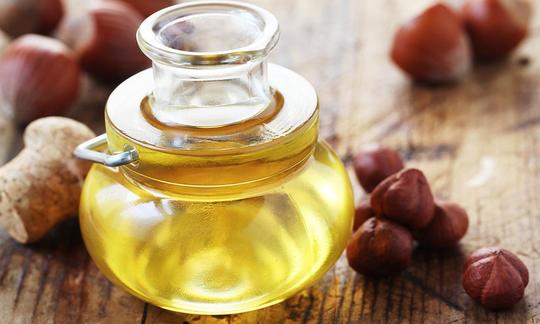Hazelnut oil is the vegetable oil extracted from the kernels of hazelnuts. With its sweet, nutty aroma, it can give dishes a special flavor.
Use in the kitchen:
The cold-pressed, light yellow, clear hazelnut oil can be used in many ways in the kitchen. It is ideal for refining all kinds of salad dressings, as it gives them a tasty, particularly spicy character. The nutty oil is also wonderful for seasoning vegetables, fruit salads or dips. The oil should only be heated in exceptional cases and, above all, not too much.
| Not only vegans or vegetarians should read this: Vegans often eat unhealthily. Avoidable nutritional errors. |
Purchasing:
Hazelnut oil is usually made from raw hazelnuts by cold pressing. This produces native hazelnut oil. This still contains a large proportion of the valuable components and vitamins. Hazelnut oil made from roasted nuts is also occasionally available on the market. The roasting process intensifies the color and flavor, which is why these oils are also often used in the kitchen. In addition to cold pressing, you should make sure that the hazelnut oil is organic. This is the only way to be sure that the hazelnut bushes from which the nuts come are not contaminated with pesticides.
Cold-pressed oils (laws, raw food)
In Switzerland, oil is referred to as cold-pressed oil if the oilseed was not heated, the pressing temperature did not exceed 50 °C and no problematic post-treatment took place.
According to the Federal Department of Home Affairs ( FDHA), an edible oil is considered cold-pressed (or may be described with synonyms such as (extra) virgin, unrefined, cold-pressed or natural) if it has been obtained by pressing or centrifuging from previously unheated raw materials, the temperature during pressing did not exceed 50 °C and it has not been subjected to refining, i.e. no neutralisation, no treatment with adsorbents, bleaching earth or steaming.
An oil may be described as “gently steamed” if the refining process was limited to steaming and the temperature did not exceed 130 °C. 3
In the EU and the USA, there does not appear to be a generally applicable temperature limit set by law for cold-pressed oils. For example, the guidelines for edible fats and oils of the Federal Ministry of Food and Agriculture (D) are written in a similar way to the EDI regulation, but they do not specify a permissible maximum temperature for general cold pressing - since they only apply to products whose labelling and composition are not conclusively set by law (i.e. not for olive oil, cocoa butter, milk fats, spreadable fats, for example). 4
However, both the EU directives and the amendment to the EDI regulation on edible oil provide for special rules for the labelling of olive oils. 5,6
These are selective marketing rules in which the term raw food is not defined. "Raw food" and "raw" are therefore not state-protected terms (as is the case with the term "organic"), which leaves a lot of room for interpretation. Although it is agreed that with purely mechanical cold pressing, the pressing temperatures generally do not exceed 40 °C, one should not naively assume that cooking oils are raw food quality. There is a suspicion that the measuring method used does not indicate the temperature in the press cylinder (where the heat is highest), but only the outlet temperature in the oil hose. With water-cooled olive oil presses (so-called "water-cooled 37°" oil presses), one probably cannot even say with certainty what the exact temperature is inside the press cylinder, because the entire press cylinder is surrounded by cooling sleeves.
In addition, the pressing pressure and speed as well as the moisture content of the oilseed affect the pressing temperature. If, for example, the moisture content is too low, the temperature rises during pressing and it is difficult to stay even below the maximum limit of 50 °C. 7
Storage:
If stored in a cool, airtight place, hazelnut oil will last for around 12 months. However, once the bottle has been used, it should be consumed quickly to avoid rancidity.
Ingredients:
Hazelnuts provide one of the highest levels of monounsaturated fatty acids, with oleic acid being the dominant fatty acid. The proportion of monounsaturated fatty acids is 78%. The chemical composition is very similar to olive oil. Like some other oils, hazelnut oil contains a high proportion of vitamin E.
You can find all the ingredients, the coverage of the daily requirement and comparison values with other ingredients in our nutrient tables. In the article Nutrients explained you will get a detailed insight into the topic.
Health aspects:
Hazelnut oil does not contain alpha-linolenic acid ALA - but a high proportion of linoleic acid LA - and therefore does not have an ideal fatty acid ratio.
Dangers/Intolerances:
Allergic reactions to hazelnuts are increasing. Food sensitizations to hazelnut allergens (especially Cor a 9, Cor a 14) are often also pronounced against peanut allergens (Ara h 2). 1 Although the oil does not actually contain any proteins, not only the nut but also the oil can be problematic for allergy sufferers in certain cases.
Use as a medicinal plant:
The oil is very popular in skin care. Hazelnut oil provides long-lasting moisture, especially for very dry, brittle or mature skin.
From Wikipedia : Hazelnut leaves ( Folia Coryli avellanae ) are used as a medicine. They contain 0.04% essential oils, palmitic acid, paraffin, myricitroside, sucrose, taraxerol and beta-sitosterol. They are used in tea mixtures as a substitute for the leaves of Hamamelis virginiana (Witch Hazel). 2
Occurrence:
Hazelnut oil is extracted from the nuts of the hazelnut bush. This is native to Europe and can also be found in the wild. Hazelnuts have always been a popular food and a valuable source of nutrients. Today, hazelnuts are mainly grown in Turkey, Spain, Italy, the USA and the Caucasus.
General information:
Hazelnut oil is not only used as cooking oil, but is also a raw material for the cosmetics industry.
The common hazel ( Corylus avellana), also known as the hazel bush or hazelnut bush, is a plant species from the birch family (Betulaceae). It is a deciduous shrub that usually grows to around five metres in height and is native to Europe and Asia Minor and very common in Central Europe. It is known for its edible fruit, hazelnuts, which have been used by humans for thousands of years. However, the majority of hazelnuts available in stores come from the closely related Lambert hazel ( Corylus maxima). 2
Literature / Sources:
Bibliography - 7 Sources (Link to the evidence)
| 1. | Altmeyers Enzyklopaedie. Haselnussallergie. enzyklopaedie-dermatologie.de/ allergologie/haselnussallergie-19052 |
| 2. | Wikipedia Gemeine Hasel. |
| 3. | Verordnung des EDI über Speiseöl, Speisefett und daraus hergestellte Erzeugnisse vom 23. November 2005 (Stand am 1. April 2008), Art. 3a und 3b. |
| 4. | bmel.de Leitsätze für Speisefette und Speiseöle. Neufassung vom 02.07.2020 (BAnz AT 18.08.2020 B3, GMBl 2020 S. 530). |
| 5. | Amtsblatt der Europäischen Union. Durchführungsverordnung (EU) Nr. 29/2012 der Kommission vom 13. Januar 2012 mit Vermarktungsvorschriften für Olivenöl. Artikel 5 a) und b). 14.1.2012. |
| 6. | Verordnung des EDI über Speiseöl, Speisefett und daraus hergestellte Erzeugnisse. Änderung vom 25. November 2013. Art. 2b. |
| 7. | Schaufler D. Oilseed Fact Sheet: Oilseed Presses. Dept. of Agricultural and Biological Engineering, Penn State College of Agricultural Sciences. |








Comments